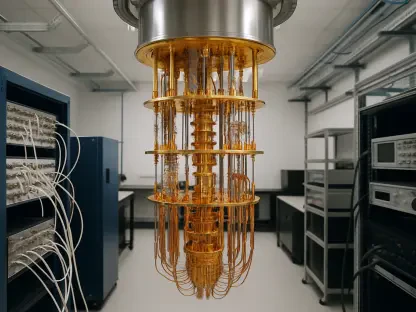Setting the Stage for Networking’s New Frontier
In an era where digital transformation dictates business success, the networking industry stands at a pivotal crossroads, with artificial intelligence (AI) reshaping data demands at an unprecedented pace, and industry projections suggesting that AI workloads will drive a 60% to 80% growth in specialized networking segments over the next several years. This explosive trend places companies like Arista Networks at the forefront of a market poised for monumental change. Headquartered in Santa Clara, California, Arista has transitioned from a niche player to a dominant force in high-performance networking. This market analysis delves into the key trends propelling Arista’s ascent, examines current data and strategic moves, and offers projections for its role in shaping the future of enterprise and AI-driven connectivity. The purpose is to provide stakeholders with actionable insights into how these dynamics influence investment and operational decisions in a rapidly evolving landscape.
Unpacking Market Trends and Strategic Positioning
AI Networking: A Catalyst for Exponential Growth
The surge in AI applications has created a seismic shift in networking requirements, positioning AI data centers as a critical growth engine for industry leaders. Arista Networks has capitalized on this trend by developing high-performance gear tailored for both front-end and back-end AI demands. With Ethernet gaining traction over alternatives like InfiniBand due to cost-effectiveness and ease of integration, Arista’s Etherlink portfolio is well-aligned to capture significant market share. Projections indicate a robust growth trajectory for this segment, potentially expanding by over 60% between now and 2027, driven by the rise of “AI centers” that streamline complex network management. This trend highlights a clear opportunity for sustained revenue increases, though it comes with the challenge of maintaining technological superiority amidst fierce competition from established players.
Beyond raw performance, the increasing complexity of AI workloads demands innovative solutions for scalability and security. Arista’s focus on creating dedicated infrastructure for AI environments addresses these needs, ensuring low-latency and high-throughput capabilities essential for real-time processing. However, the market remains dynamic, with competitors racing to close the innovation gap. The ability to anticipate and adapt to emerging AI use cases—such as advanced machine learning models requiring massive data transfers—will likely determine long-term leadership. For now, Arista’s early-mover advantage positions it favorably to ride this transformative wave over the coming years.
Enterprise Market Penetration: Targeting Campus and WAN Opportunities
Parallel to AI advancements, the enterprise networking segment is witnessing heightened demand for mission-critical solutions, particularly in campus and wide-area network (WAN) environments. Arista is aggressively targeting this space, aiming to grow its current run rate of approximately $750-800 million to $1.25 billion, a striking 60% increase. This push is fueled by the growing centrality of networks to business operations across diverse sectors, including hospitality and retail, where downtime can result in significant losses. With AI inferencing traffic placing additional strain on enterprise systems, the need for resilient, high-performance infrastructure has never been more apparent, creating fertile ground for Arista’s offerings.
Despite this potential, scaling beyond the largest global corporations presents notable hurdles. Arista’s channel strategy remains underdeveloped, limiting its reach into mid-tier enterprises that rely heavily on system integrators and value-added resellers for procurement. Strengthening partnerships and enhancing lead-generation efforts are essential to overcoming this barrier, though such moves may require margin trade-offs to incentivize channel partners. Success in this arena hinges on balancing direct sales expertise with a robust indirect sales ecosystem, a strategic pivot that could redefine Arista’s market penetration over the next few years.
Technological Innovations: Redefining Network Management
Innovation remains a cornerstone of Arista’s competitive edge, with tools like the Autonomous Virtual Assistant (AVA) and the “Blue Box” hardware concept setting new benchmarks in network efficiency. AVA, leveraging real-time telemetry and predictive analytics via Arista’s Network Data Lake, acts as a proactive co-pilot for engineers, identifying potential issues before they escalate. This aligns with a broader industry trend toward autonomous network management, where customer surveys reveal a strong willingness to switch vendors for superior AI-driven capabilities. Such tools enhance operational reliability, a critical factor as networks become integral to business continuity.
The Blue Box initiative, meanwhile, targets hyperscalers and large-scale cloud providers with cost-effective, scalable hardware that maintains high efficiency through advanced diagnostic layers. This adaptability showcases Arista’s ability to cater to diverse customer segments, from premium enterprise solutions to budget-conscious cloud environments. Yet, market education remains a challenge, as misconceptions about AI tools replacing human expertise could slow adoption. Addressing regional variations in technological readiness and ensuring seamless integration will be key to maximizing the impact of these innovations across global markets.
Forecasting the Path Ahead: Opportunities and Challenges
Looking into the near future, several transformative trends are expected to shape the networking landscape, with Arista well-positioned to lead through strategic foresight. The continued rise of AI-driven workloads will likely sustain demand for high-performance solutions, with Arista’s specialized portfolios poised for a multi-year growth runway. Industry data suggests that Ethernet adoption in AI centers will further accelerate, offering a competitive advantage over alternative technologies. Additionally, as networks become indispensable to business operations—a fact underscored by 93% of surveyed professionals noting their increased importance—Arista’s enterprise solutions are set to see heightened adoption, provided channel challenges are addressed.
Potential headwinds, including regulatory shifts around data privacy and economic fluctuations, could impact market dynamics, influencing the pace of technology adoption. Nevertheless, optimistic projections point to Arista maintaining its edge through relentless innovation and strategic market expansion. Emerging advancements in autonomous systems are anticipated to further solidify its position, assuming operational execution remains consistent. Competitive pressures will persist, requiring ongoing investment in research and development to stay ahead. The interplay of these factors suggests a promising yet complex trajectory, with Arista’s ability to navigate these challenges critical to achieving ambitious revenue targets, including a $10 billion milestone in the coming years.
Reflecting on Insights and Strategic Next Steps
Reflecting on the analysis, Arista Networks demonstrates remarkable progress in carving out a leadership role within the networking industry, driven by its adept handling of AI and enterprise market trends. The examination of current patterns reveals a strong alignment with transformative industry shifts, while projections point to sustained growth through targeted innovation. These findings underscore the pivotal role of networking in modern business ecosystems, with Arista’s strategic moves positioning it as a key player in this evolution.
Moving forward, stakeholders should consider several actionable steps to leverage these insights. Businesses seeking to enhance operational efficiency might explore partnerships with Arista to adopt cutting-edge solutions tailored for AI and mission-critical environments. IT professionals could benefit from upskilling in autonomous network management tools to align with emerging standards. For Arista itself, prioritizing the development of a robust channel ecosystem emerges as a critical focus to unlock broader enterprise potential. Additionally, continued investment in market education around AI tools could accelerate adoption rates. These strategies, if executed effectively, promise to shape a resilient future for both Arista and the wider networking landscape, ensuring adaptability in an era of relentless digital change.









